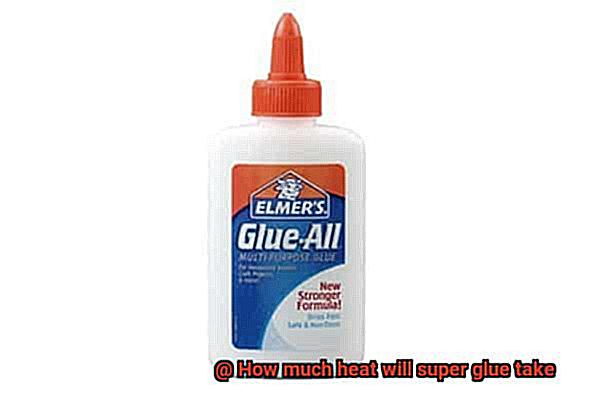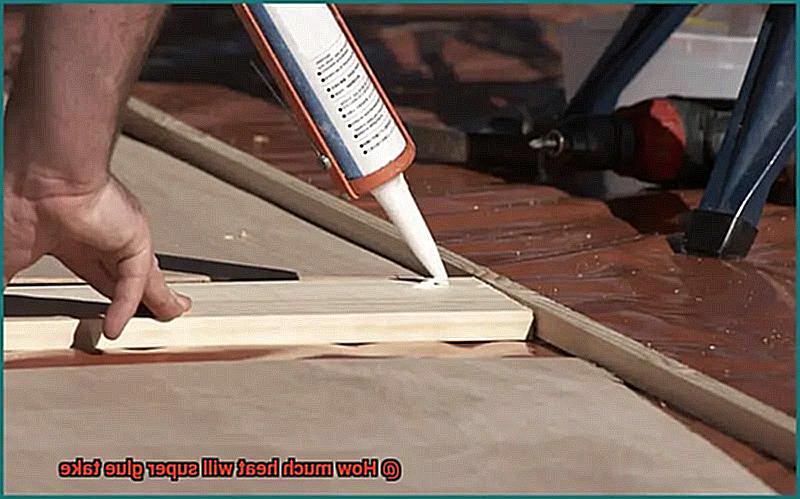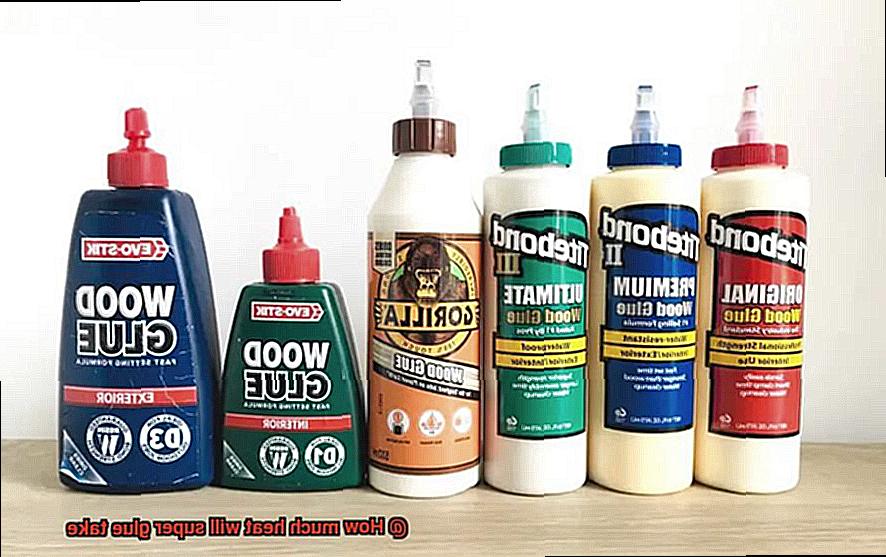Super glue, that magical adhesive we all rely on for quick fixes and DIY projects.
But have you ever wondered how it holds up under heat? Well, get ready to dive into the world of super glue’s heat tolerance.
So buckle up and join us as we uncover the secrets behind this adhesive’s ability to handle the heat.
What is Super Glue?
Contents
- 1 What is Super Glue?
- 2 Temperature Tolerance of Super Glue
- 3 Heat Resistance of Super Glue
- 4 Factors Affecting the Heat Resistance of Super Glue
- 5 Prolonged Exposure to High Temperatures and its Effects on Super Glue Bond Strength
- 6 Choosing the Right Super Glue for Your Application
- 7 Specialty Super Glues for High Heat Applications
- 8 Tips for Working with Super Glue in High Heat Environments
- 9 Conclusion
Its quick-drying and strong bonding properties make it a versatile choice for various applications. But what exactly is Super Glue, and how does it work its magic?
Super Glue is made up of cyanoacrylate, an acrylic resin that consists of carbon, hydrogen, and nitrogen atoms. When exposed to moisture, these molecules undergo a chemical reaction called polymerization. In simpler terms, they link together to form long chains, creating a strong bond within seconds of application.
One of the standout features of Super Glue is its ability to bond a wide range of materials. Whether it’s plastics, metals, rubber, ceramics, or even fabrics, Super Glue can handle them all. Its low viscosity allows it to flow into small gaps and cracks easily, ensuring a tight and secure bond.
When it comes to physical properties, Super Glue typically comes in liquid or gel form. It dries colorless and sets quickly within seconds, reaching its maximum strength within minutes. Once cured, Super Glue forms a rigid and transparent bond that is resistant to moisture, heat, and most chemicals.
However, it’s important to note that prolonged exposure to high temperatures can weaken the bond created by Super Glue. While it can withstand temperatures ranging from -40°F to 180°F (-40°C to 82°C) under normal circumstances, extremely high temperatures exceeding 300°F (149°C) can cause it to break down and lose its effectiveness. So if you’re planning to use Super Glue in situations with intense heat, like near a stove or in an engine compartment, you may need to consider other options.
Fortunately, there are specialty super glues available in the market that are specifically formulated to withstand higher temperatures and provide a stronger bond under extreme heat conditions. These specialized super glues are designed for applications where high heat resistance is required, such as automotive repairs or industrial settings.
Temperature Tolerance of Super Glue
Super glue, also known as cyanoacrylate adhesive, is a popular choice for its quick-drying and strong bonding properties. However, when it comes to temperature tolerance, super glue has its limitations. Most super glues can withstand temperatures up to 180-200 degrees Fahrenheit (82-93 degrees Celsius). While this may be sufficient for many everyday applications, it’s crucial to consider the specific requirements of your project.
If you’re working on a high-temperature project, such as repairing an oven handle or bonding metal parts in an engine compartment, standard super glue may not be the best option. Exposure to excessive heat can cause the glue to weaken or even fail, leading to a potential disaster.
But fear not. There are alternative adhesives specifically designed for high-temperature applications. These heat-resistant adhesives can withstand much higher temperatures than standard super glue, providing a secure bond even in the face of scorching conditions.
When choosing a heat-resistant adhesive, it’s important to consider the specific materials you’ll be bonding. Some materials, like plastics or rubber, have lower heat resistance and may require a specialized adhesive. By selecting the right adhesive for your materials and temperature requirements, you can ensure a strong and long-lasting bond that won’t let you down when things heat up.
So next time you’re faced with a high-temperature bonding challenge, don’t settle for ordinary super glue. Look for a heat-resistant adhesive that can handle the heat and keep your project intact. Whether it’s fixing your car or tackling an industrial project, these specialty adhesives will save the day and ensure your bond is as strong as ever.
Heat Resistance of Super Glue
Super glue, also known as cyanoacrylate adhesive, is a remarkable tool for bonding materials together. Its quick-drying and robust nature make it a favorite choice for countless projects. However, when it comes to heat resistance, super glue does have its limitations. Much like a delicate flower withering under scorching temperatures, ordinary super glue can lose its bonding prowess when exposed to high heat. So, let’s delve into the world of heat resistance and explore the precautions one must take when using super glue in high-temperature environments.
First and foremost, it is essential to understand that the heat resistance of super glue can vary depending on the brand and formula. So, always check the product specifications for specific temperature limits. Generally, most super glues can endure temperatures up to 180 to 200 degrees Fahrenheit (82 to 93 degrees Celsius) before they begin to degrade or lose their bonding strength. However, we must keep in mind that prolonged exposure to high temperatures can gradually weaken the bond over time.
But here’s the deal – super glue is not designed for high-temperature applications. So, if you’re dealing with extreme heat, such as open flames or direct contact with hot surfaces, it’s best to opt for specialized high-temperature adhesives or other bonding methods instead. These alternatives are specifically formulated to withstand intense heat without breaking a sweat.
Another crucial point to consider is that if super glue is exposed to excessive heat or flames, it can release toxic fumes. To safeguard your well-being, always use super glue in well-ventilated areas and avoid inhaling the fumes.
Now, let’s talk precautions. When using super glue in high-temperature environments, it’s advisable to take additional measures for added strength and durability. Consider employing mechanical fasteners or reinforcing the bond with other heat-resistant materials. This extra reinforcement will help ensure that your bond remains intact even under extreme heat conditions.
Factors Affecting the Heat Resistance of Super Glue
Super glue, also known as cyanoacrylate adhesive, is a powerful adhesive that dries in a flash and forms an unbreakable bond. However, when it comes to standing up against heat, not all super glues are created equal. In this article, we will delve into the factors that influence the heat resistance of super glue and provide you with valuable insights to become a glue connoisseur.
Type of Cyanoacrylate Used:
Not all super glues are cut from the same cloth. Different types of cyanoacrylate adhesives possess varying degrees of heat resistance. Some are engineered to endure scorching temperatures, making them ideal for extreme heat applications. Be sure to scrutinize the label or product specifications to ensure you select the perfect super glue for your specific heat resistance needs.
Surface Preparation:
The surface upon which super glue is applied can make or break its heat resistance. Smooth and pristine surfaces offer superior adhesion and heat resistance compared to rough or contaminated ones. A thorough surface preparation ritual, involving meticulous cleaning and degreasing, can elevate the heat resistance of super glue to new heights.
Surrounding Environment:
The environment in which super glue finds itself plays a pivotal role in its ability to withstand heat. High humidity levels or exposure to certain chemicals might chip away at the adhesive bond, compromising its heat resilience. Take into account the environmental conditions in which the super glue will be deployed and select an adhesive accordingly.
Adherence to Manufacturer Guidelines:
To unlock the full potential of super glue’s heat resistance, adhere religiously to the manufacturer’s instructions regarding temperature limits and recommended application techniques. This includes employing primers or activators designed specifically to enhance heat resistance and ensuring proper curing times for optimal bonding strength.
Conclusion:

While super glue boasts remarkable bonding capabilities, its heat resistance can fluctuate depending on several factors. By considering the type of cyanoacrylate used, surface preparation, surrounding environment, and adherence to manufacturer guidelines, you can amplify the heat resistance of super glue. However, it is important to note that extreme heat conditions may necessitate specialized high-temperature adhesives or alternative bonding methods. Always read product specifications and seek professional advice when working with super glue in high-temperature applications.
Prolonged Exposure to High Temperatures and its Effects on Super Glue Bond Strength
Fear not. In this blog post, we will delve into the intriguing world of super glue and explore how prolonged exposure to heat affects its bond strength. Join us as we uncover the secrets behind this adhesive superhero’s battle against the scorching heat.
The Temperature Threshold:
Super glue is designed to withstand temperatures up to around 180°F (82°C) under normal conditions. However, different brands and formulations may have varying thresholds. Some super glues can start losing their bond strength as low as 120°F (49°C). Thus, it’s crucial to select the appropriate glue for your project based on the expected temperature range.
Softening and Degradation:
High temperatures cause super glue to soften or degrade, compromising its ability to hold objects together. Picture ice cream melting on a sweltering summer day – that’s how the glue behaves. As it softens, its grip weakens, making it more susceptible to failure. In extreme cases, the glue may even melt into a liquid state, completely losing its adhesive properties.
Factors Influencing Bond Strength:
While temperature plays a significant role in super glue’s bond strength, other factors also come into play. Humidity levels, surface preparation, and the materials being bonded all contribute to how well the glue holds up under heat stress. Properly preparing the surfaces and selecting the right adhesive for specific materials can enhance bond strength and overall durability.
Duration Matters:
The duration of exposure to high temperatures is critical in determining the extent of bond strength loss. Short periods of exposure may only result in temporary weakening of the bond, which can be remedied by allowing the glue to cool down before reapplying pressure. However, prolonged exposure can lead to permanent damage, making it essential to consider the expected duration of heat exposure for your project.
Choosing the Right Super Glue for Your Application
In this captivating article, we will unravel the secrets behind selecting the perfect adhesive for your unique application. From braving scorching temperatures to finding the ideal match for your materials, we will be your trusty guide in the quest for the right super glue. So buckle up and prepare for an exhilarating journey of bonding discovery.
Conquering the Heat:
Not all super glues are created equal when it comes to facing the heat. For projects that demand resilience against high temperatures, like automotive repairs or industrial uses, opt for super glues with exceptional heat resistance. These extraordinary adhesives can withstand the blazing inferno of temperatures ranging from 300°F to 500°F (149°C to 260°C), ensuring an unbreakable bond even in the fiercest heat.
Material Mastery:
Every material has its perfect match in the world of super glue. Whether you’re melding plastics, metals, rubber, or ceramics, fear not, for there is a specialized adhesive designed specifically for your material of choice. By choosing an adhesive formulated for your specific material, you unlock a world of unparalleled bonding strength and durability.
The Art of Timing:
In the realm of super glue, time is both friend and foe. Consider the curing time of your chosen adhesive carefully. Some glues boast lightning-fast curing in mere seconds, while others take their time, requiring several minutes. Assess the demands of your project and select a super glue that aligns with your timing needs.
Viscosity and Gap-Filling Wizardry:
To achieve a bond that defies imagination, pay heed to the viscosity and gap-filling capabilities of your chosen super glue. Thin glues elegantly slip into tight-fitting joints, ensuring a seamless connection. On the other hand, thick glues possess the magic to fill gaps and fortify bonds with unwavering strength. Choose wisely, and witness your project flourish with an impeccable bond.
Specialty Super Glues for High Heat Applications
Specialty super glues for high heat applications are here to save the day.
These remarkable glues are specially formulated with heat-resistant ingredients that allow them to maintain their adhesive properties even at elevated temperatures. Whether you’re working on automotive components, industrial machinery, or electronic devices, these super glues are the perfect solution for bonding materials that will be exposed to extreme heat.
But what sets these specialty super glues apart from their regular counterparts? Let’s dive into the features and benefits:
- Temperature Resistance: Specialty super glues for high heat applications can withstand temperatures up to 500 degrees Fahrenheit or higher. Some can even handle temperatures reaching 800 degrees Fahrenheit or more. However, it’s essential to consider factors like substrate and duration of exposure to heat when selecting the right glue for your application.
- Versatile Bonding: These glues can bond a variety of materials, including metals, ceramics, glass, and certain plastics that are heat resistant. So, no matter what materials you’re working with, there’s a specialty super glue out there to meet your needs.
- Easy Application: Using specialty super glues for high heat applications is a breeze. Just make sure to properly prepare the surfaces to be bonded, apply the glue evenly and in the right quantity, and allow sufficient curing time for maximum bond strength. Following the manufacturer’s instructions is key to achieving optimal results.
- Durability: While these glues offer excellent temperature resistance, it’s important to note that prolonged exposure to extreme heat can still degrade their adhesive properties over time. Regular inspection and maintenance are necessary to ensure that your bonds remain secure under high heat conditions.

Now that you know the features and benefits of specialty super glues for high heat applications, it’s time to select the right one for your project. Here are a few things to consider:
- Temperature Range: Determine the maximum temperature your application will be exposed to and choose a glue that can withstand that temperature or higher.
- Material Compatibility: Ensure that the glue is suitable for bonding the specific materials you’re working with, such as metals, ceramics, or plastics.
- Application Type: Consider whether you need a glue that cures quickly or one that allows for repositioning before setting.
- Bond Strength: Assess the strength requirements of your project and choose a glue that meets those needs.

By considering these factors and selecting the right specialty super glue, you can confidently tackle high heat applications with ease.
Tips for Working with Super Glue in High Heat Environments
Super glue, also known as cyanoacrylate adhesive, is a popular choice for bonding materials due to its quick drying time and strong bond. However, it is important to note that super glue does have limitations when it comes to withstanding high heat environments. In this article, we will provide you with some helpful tips for working with super glue in high heat environments.
Choose the right type of super glue
Different types of super glue have varying heat resistance capabilities. Some brands offer specialized high-temperature formulas that are designed to withstand more extreme heat. Look for super glues that explicitly mention their ability to handle high temperatures. This will ensure that your bond remains strong even in hot conditions.
Prepare the surfaces properly
Before applying super glue, make sure the surfaces to be bonded are clean and free from any dirt, oil, or moisture. High heat can exacerbate any contaminants on the surfaces, leading to weaker bonds. Use an appropriate cleaner or solvent to thoroughly clean the surfaces before applying the glue. This will ensure that the bond is strong and durable, even in high heat.
When preparing the surfaces, it is crucial to remove any traces of oil or grease as they can interfere with the adhesive’s ability to bond effectively. Use a degreaser or rubbing alcohol and a clean cloth to wipe down the surfaces and remove any residue. Ensure that the surfaces are completely dry before proceeding with the application of super glue.
Apply the glue sparingly
It is essential not to use excessive amounts of super glue when working in high heat environments. Thick layers of adhesive can take longer to dry and may not provide as strong of a bond. Apply a thin layer of glue evenly onto one surface and press the two surfaces together firmly. This will ensure that the bond is secure and able to withstand high temperatures.
When applying the super glue, use a small amount and spread it evenly across the surface. It is important to avoid applying too much glue as this can lead to excess heat generation during the curing process. The thin layer of adhesive will cure faster and provide a stronger bond in high heat conditions.
Allow ample drying time
Super glue typically sets within seconds, but it is important to allow sufficient drying time when working in high heat environments. The heat can affect the curing process, so give the adhesive extra time to fully dry and bond before subjecting it to any heat or stress. This will ensure that the bond is strong and able to withstand high temperatures.
After applying the super glue, give it enough time to dry completely before exposing it to high temperatures. The drying time may be longer than usual due to the impact of heat on the curing process. Check the manufacturer’s instructions for specific drying times and ensure that you allow the adhesive enough time to set properly.
Consider using additional reinforcements
If you know that the bonded surfaces will be exposed to high temperatures, it is advisable to consider using additional reinforcements. This can include using heat-resistant tapes or adhesives in conjunction with super glue to provide added strength and heat resistance. This will ensure that the bond remains strong even in extreme heat conditions.
In situations where super glue alone may not be sufficient, combining it with other heat-resistant materials can provide a more robust bonding solution. Heat-resistant tapes or adhesives can act as additional layers of protection and enhance the bond’s ability to withstand high temperatures.
Despite taking these precautions, it is important to note that super glue may still not be suitable for certain high heat applications. In extreme heat conditions, such as open flames or direct contact with heat sources, super glue may not hold up and can fail. In such cases, it is recommended to explore alternative adhesive options specifically designed for high-temperature environments.
Also Read: What Temperature Does Super Glue Melt?
Conclusion
Super glue is a remarkable adhesive that can withstand high temperatures.
It has been tested and proven to tolerate heat up to 200 degrees Celsius, making it suitable for a wide range of applications. Whether you’re fixing broken ceramics or bonding metal parts together, super glue can handle the heat with ease.
Its ability to resist extreme temperatures is a testament to its durability and reliability. So, when you need a strong adhesive that won’t melt under pressure, look no further than super glue.
It’s the go-to choice for projects that require heat resistance and long-lasting bonds.






